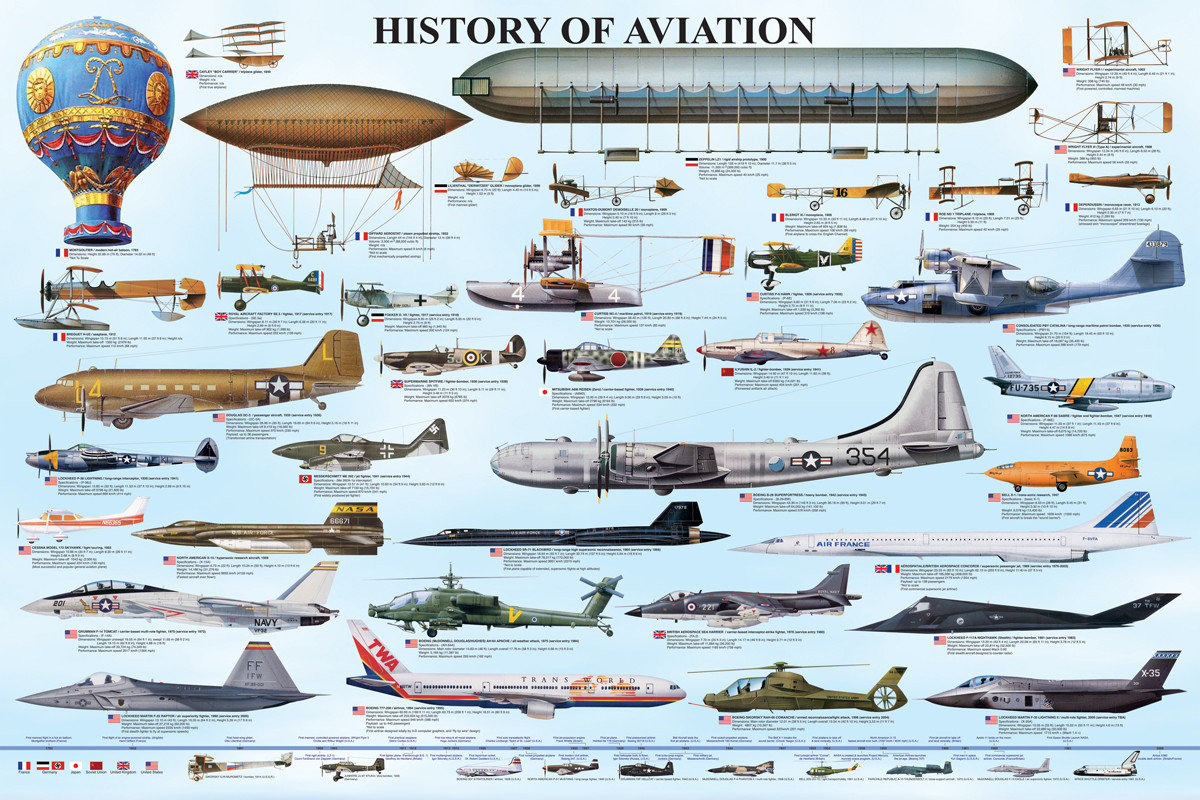Aviation History
Carriers have been proposed as an expected modest choice to surface rocket dispatches for accomplishing Earth circle. JP Aviation has proposed the Carrier to Circle project, which expects to drift a multi-stage carrier up to mesospheric elevations of 55 km (180,000 ft) and afterward use particle impetus to advance to orbital speed. At these levels, air opposition wouldn’t be a huge issue for accomplishing such paces. The organization has not yet assembled any of the three phases.
NASA has proposed the High Elevation Venus Functional Idea, which contains a progression of five missions remembering monitored missions to the air of Venus for carriers. Pressures on the outer layer of the planet are excessively high for human residence, yet at a particular height the tension is equivalent to that tracked down on The planet and this makes Venus a possible objective for human colonization.
The benefit of aircrafts over planes is that static lift adequate for flight is created by the lifting gas and requires no motor power. This was an enormous benefit before the center of The Second Great War and stayed a benefit for significant distance or long-span tasks until The Second Great War. Current ideas for high-elevation carriers incorporate photovoltaic cells to decrease the need to land to refuel, accordingly they can stay in the air until consumables terminate.
The disservices are that a carrier has an extremely huge reference region and similarly enormous drag coefficient, consequently a bigger drag force contrasted with that of planes and even helicopters. Given the enormous front facing region and wetted surface of a carrier, a reasonable breaking point is stretched around 130-160 kilometers each hour (80-100 mph). Consequently aircrafts are utilized where speed isn’t basic.
The lift capacity of an aircraft is equivalent to the light power short the heaviness of the carrier. This expects standard air-temperature and strain conditions. Remedies are normally made for water fume and pollution of lifting gas, as well as a level of expansion of the gas cells at takeoff. In view of explicit lift (lifting force per unit volume of gas), the best static lift is given by hydrogen (11.15 N/m3 or 71 lbf/1000 cu ft) with helium (10.37 N/m3 or 66 lbf/1000 cu ft) a nearby second. At 6.13 N/m3 (39 lbf/1000 cu ft), steam is a far off third. Other modest gases, for example, methane, carbon monoxide, alkali and gaseous petrol have even less lifting limit and are combustible, poisonous, destructive, or every one of the three (neon is much more expensive than helium, with less lifting limit). Functional contemplations, for example, whether the lift gas can be monetarily vented and created in trip for control of lightness (similarly as with hydrogen) or even delivered as a side-effect of impetus (likewise with steam) influence the useful decision of lift gas in carrier plans.
Notwithstanding the static lift, a carrier can get a specific measure of dynamic lift from its motors. Dynamic lift in past aircrafts has been around 10% of the static lift. Dynamic lift permits a carrier to “take off weighty” from a runway like fixed-wing and turning wing airplane. In any case, this requires extra weight in motors, fuel and landing gear, discrediting a portion of the static lift limit.
The elevation at which an aircraft can fly to a great extent relies on how much lifting gas it can lose because of development before balance is reached. A definitive elevation record for an unbending carrier was set in 1917 by the L-55 under the order of Hans-Kurt Flemming when he constrained the carrier to 7,300 m (24,000 ft) endeavoring to cross France after the “Quiet Strike” on London. The L-55 lost lift during the drop to bring down elevations over Germany and crashed because of loss of lift. While such misuse of gas was vital for the endurance of carriers in the later long periods of The Second Great War, it was unfeasible for business tasks or activities of helium-filled military aircrafts. The most elevated flight made by a hydrogen-filled traveler carrier was 1,700 m (5,500 ft) on the Graf Blimp’s around-the-world flight. As far as possible for inflexible carriers was around 900 m (3,000 ft), and for pressure aircrafts around 2,400 m (8,000 ft).
Current carriers utilize dynamic helium volume. Adrift level height, helium takes up just a little piece of the body, while the rest is loaded up with air. As the carrier climbs, the helium expands with decreased external strain, and the air is pushed out and let out of the descending valve. This permits a carrier to arrive at any elevation with adjusted inward and external tension assuming the lightness is sufficient. Some polite aerostats could arrive at 100,000 ft (30,000 m) without blast because of over-burden inward strain.
The best hindrance of the aircraft is size, which is fundamental for expanding execution. Concerning size builds, the issues of ground dealing with increment mathematically. As the German Naval force transformed from the P class of 1915 with a volume of north of 31,000 m3 (1,100,000 cu ft) to the bigger Q class of 1916, the R class of 1917, lastly the W class of 1918, at very nearly 62,000 m3 (2,200,000 cu ft) ground taking care of issues diminished the quantity of days the Dirigibles had the option to make watch flights. This accessibility declined from 34% in 1915, to 24.3% in 1916 lastly 17.5% in 1918.
Insofar as the ability to-weight proportions of airplane motors stayed low and explicit fuel utilization high, the carrier had an edge for long-range or – term tasks. As those figures changed, the equilibrium moved quickly in the plane’s approval. By mid-1917, the carrier could never again make due in a battle circumstance where the danger was planes. By the last part of the 1930s, the aircraft scarcely enjoyed an upper hand over the plane on intercontinental over-water flights, and that benefit had evaporated toward the finish of The Second Great War.
This is in eye to eye strategic circumstances. Right now, a High-elevation carrier project is intended to review many kilometers as their activity sweep, frequently a lot farther than the ordinary commitment scope of a tactical plane. For instance, a radar mounted on a vessel stage 30 m (100 ft) high has radio skyline at 20 km (12 mi) range, while a radar at 18,000 m (59,000 ft) height has radio skyline at 480 km (300 mi) range. This is fundamentally significant for distinguishing low-flying voyage rockets or warrior aircraft.
The most generally utilized lifting gas, helium, is inactive so presents no fire risk. Current carriers have a characteristic lightness and exceptional plan that offers a basically zero disastrous disappointment mode. A progression of weakness tests were finished by the UK Safeguard Assessment and Exploration Organization DERA on a Skyship 600. Since the inward gas pressure was kept up with at just 1-2% over the encompassing pneumatic stress, the vehicle demonstrated exceptionally lenient to actual harm or to go after by little arms fire or rockets. A few hundred high-speed slugs were terminated through the structure, and, surprisingly, after two hours the vehicle would have had the option to get back to base. Arms went through the envelope without causing basic helium misfortune. In all cases of light deadly implement fire assessed under both test and live circumstances, the aircraft had the option to finish its central goal and return to base.
High-height stage station
High-height stage station (short: HAPS) is – as per Article 1.66A of the Worldwide Telecom Association’s (ITU) ITU Radio Guidelines (RR) – characterized as “a station on an item at an elevation of 20 to 50 km and at a predefined, ostensible, fixed direct relative toward the Earth”.
Each station will be characterized by the assistance in which it works for all time or briefly.
A HAP can be a monitored or automated plane, an inflatable, or a carrier. All require electrical ability to keep themselves and their payload practical. While current HAPS are fueled by batteries or motors, mission time is restricted by the requirement for re-energizing/refueling. Thusly, elective means are being considered for what’s in store. Sunlight based cells are one of the most incredible choices as of now being involved under preliminary for HAPS (Helios, Lindstrand Robust).
Whether a carrier or a plane, a significant test is the capacity of the HAP to keep up with station keeping notwithstanding winds. A working height somewhere in the range of 17 and 22 km is picked on the grounds that in many locales of the world this addresses a layer of moderately gentle breeze and choppiness over the fly stream. Albeit the breeze profile might fluctuate extensively with scope and with the season, a structure like that shown will generally get. This elevation (> 17 km) is likewise above business air-traffic levels, which would somehow demonstrate a possibly restrictive imperative.
Since HAPS work at much lower elevations than satellites, it is feasible to successfully cover a little district considerably more. Lower height additionally amounts to a whole lot bring down media communications interface spending plan (consequently lower power utilization) and more modest full circle delay contrasted with satellites. Moreover, conveying a satellite demands huge investment and financial assets, concerning improvement and send off. HAPS, then again, are similarly more affordable and are quickly deployable. Another significant distinction is that a satellite, once sent off, can’t be arrived for upkeep, while HAPS can.
One of most recent purposes of HAPS has been for radiocommunication administration. Research on HAPS is effectively conveyed generally in Europe, where researchers are thinking about them as a stage to convey fast network to clients, over areas of up to 400 km. It has acquired critical interest since HAPS will actually want to convey data transmission and limit like a broadband remote access organization (like WiMAX) while giving an inclusion region like that of a satellite.
High-elevation aircrafts can work on the tactical’s capacity to convey in far off regions like those in Afghanistan, where sloping landscape much of the time impedes correspondences signals.
One of the most outstanding instances of a high-elevation stage utilized for observation and security is Northrop Grumman RQ-4 Worldwide Bird of prey UAV utilized by


